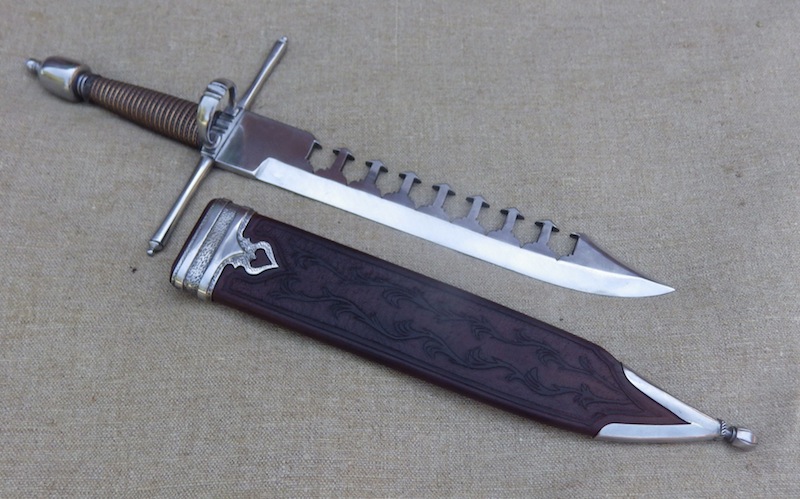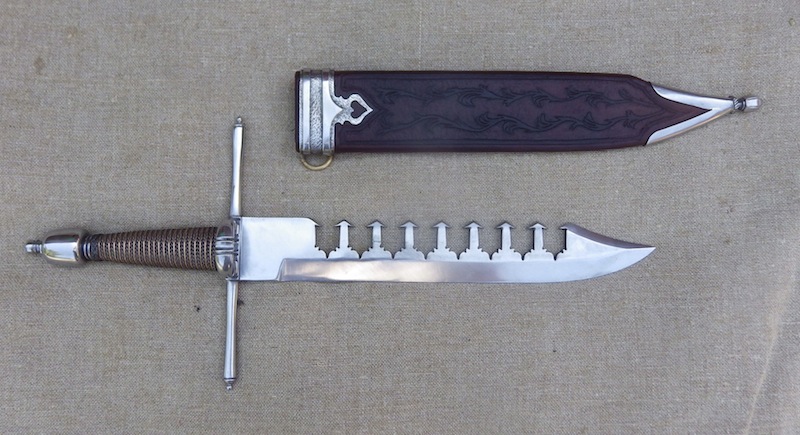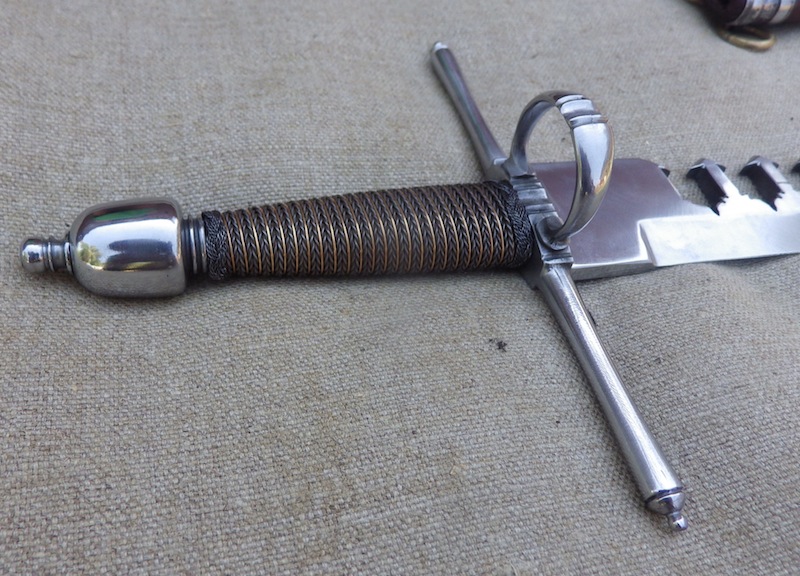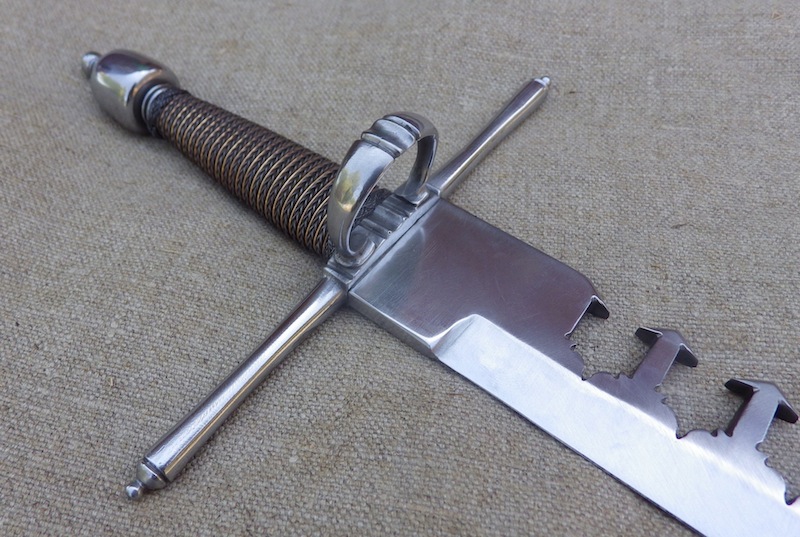| Author |
Message |
Leo Todeschini
Industry Professional

|
 Posted: Thu 01 Aug, 2013 2:38 pm Post subject: circa 1600 sword breaker Posted: Thu 01 Aug, 2013 2:38 pm Post subject: circa 1600 sword breaker |
 |
|
Hi All,
I have just finished this sword breaker based on a composite of pieces from around 1600 and I hope you like the result.
This style of knife came in at the end of the 16thC and lasted perhaps as late as the mid 17th and were used defensively to trap an opponents blade and take control of it and they do this very well. When a blade enters the void between the teeth, a pull or a twist will catch the and hold the blade. Whether they truly did 'break blades' I am not so sure, but they certainly do work.
They were not a very common form of knife and perhaps this was ether because they were bulky or expensive to make or indeed deemed to not be very useful however they are certainly very striking. The teeth were either fixed like this example or were articulated and must have been very much more expensive. They do look inherently weak, but this is partially offset by a thick blade with very little distal taper.
This example has a 6.5mm/ 1/4" thick blade, 275mm long/11.5" and has a steel guard and pommel with a steel and bronze wrapped grip with steel turks heads top and bottom.
Tod
 Attachment: 162.58 KB Attachment: 162.58 KB

 Attachment: 136.76 KB Attachment: 136.76 KB

 Attachment: 137.38 KB Attachment: 137.38 KB

 Attachment: 185.41 KB Attachment: 185.41 KB

 Attachment: 170.86 KB Attachment: 170.86 KB

 Attachment: 146.27 KB Attachment: 146.27 KB

www.todsworkshop.com
www.todcutler.com
www.instagram.com/todsworkshop
https://www.facebook.com/TodsWorkshop
www.youtube.com/user/todsstuff1
|
|
   |
 |
Boris Bedrosov
Industry Professional

|
 Posted: Thu 01 Aug, 2013 2:51 pm Post subject: Re: circa 1600 sword breaker Posted: Thu 01 Aug, 2013 2:51 pm Post subject: Re: circa 1600 sword breaker |
 |
|
| Leo Todeschini wrote: | | ...... and I hope you like the result....... |
Of course, we like it - excellent masterpiece as usual.
When I saw the pictures, but before reading your text, a couple of questions rose in my mind. Just a bit latter I saw you've answered to all of them.
For now, I have just one, purely technological question - how the ring is attached to the guard? It seems that the easiest way are integral pins, riveted at the other side, but there could be (in my opinion) at least a couple of other ways.
Of course, I hope this is not a craftsman's secret!
"Everyone who has the right to wear a long sword, has to remember that his sword is his soul,
and he has to separate from it when he separates from his life"
Tokugawa Ieyasu
Find my works on Facebook:
Boris Bedrosov's Armoury
|
|
   |
 |
|
Patrick Kelly
|
 Posted: Thu 01 Aug, 2013 5:39 pm Post subject: Posted: Thu 01 Aug, 2013 5:39 pm Post subject: |
 |
|
Outstanding work. I have a particular fondness for these daggers and yours is a beautiful rendition.
"In valor there is hope.".................. Tacitus
|
|
   |
 |
|
Mark Moore
|
 Posted: Thu 01 Aug, 2013 9:45 pm Post subject: Posted: Thu 01 Aug, 2013 9:45 pm Post subject: |
 |
|
I guess you know....Down here in Texas, we call that a saw-back Bowie knife.....  .......Just kidding! Fantastic work! .......Just kidding! Fantastic work!  ...McM ...McM
|
|
  |
 |
Marik C.S.

|
 Posted: Thu 01 Aug, 2013 11:00 pm Post subject: Posted: Thu 01 Aug, 2013 11:00 pm Post subject: |
 |
|
| Mark Moore wrote: | I guess you know....Down here in Texas, we call that a saw-back Bowie knife.....  .......Just kidding! Fantastic work! .......Just kidding! Fantastic work!  ...McM ...McM |
You are a very bad person, now I want to see a 17th Century version of Rambo with such a knife 
That dagger is awesome, would it be honed to a full edge and completely sharpened seeing as it is mainly used for parrying and controlling the opponents blade?
Europe - Where the History comes from. - Eddie Izzard
|
|
    |
 |
|
Patrick Kelly
|
 Posted: Fri 02 Aug, 2013 12:42 am Post subject: Posted: Fri 02 Aug, 2013 12:42 am Post subject: |
 |
|
Leo,
Where did you get the inspiration for the scabbard? I've never seen a photograph of a surviving specimen. I'd love to see one if you have it.
"In valor there is hope.".................. Tacitus
|
|
   |
 |
Leo Todeschini
Industry Professional

|
 Posted: Fri 02 Aug, 2013 1:04 am Post subject: Posted: Fri 02 Aug, 2013 1:04 am Post subject: |
 |
|
Thanks all for your comments - I really appreciate the kind words.
Boris Bedrosov wrote | Quote: | For now, I have just one, purely technological question - how the ring is attached to the guard? It seems that the easiest way are integral pins, riveted at the other side, but there could be (in my opinion) at least a couple of other ways.
Of course, I hope this is not a craftsman's secret! |
This is in fact a casting, but I made the master in steel as I often prefer to do this rather than wax if I am going this route. The master was fabricated with the arms and block forming one piece and the ring brazed on as a second. This is the normal method of construction.
Patrick Kelly wrote | Quote: | | Where did you get the inspiration for the scabbard? I've never seen a photograph of a surviving specimen. I'd love to see one if you have it. |
I will have to disappoint you I am afraid. I also have never seen a scabbard for one of these, so this has to be conjecture. A chape on a clipped point looks weird if it is conical, so I tend to favour the form I have used here and you see this historically on falchions etc. The locket is a usual wrapped and soldered form and as this was for a lady I cheesily used the heart motif - fitting anyway, but perhaps more so because she asked for a 'feminine sword breaker' - if that is not a contradiction!
The decoration is acanthus leaf vines and that is a timeless motif. I made one of these knives 15 years ago and tried to use an all leather scabbard and it just tended to bind and didn't really work, so I chose a wood cored scabbard this time.
Tod
www.todsworkshop.com
www.todcutler.com
www.instagram.com/todsworkshop
https://www.facebook.com/TodsWorkshop
www.youtube.com/user/todsstuff1
|
|
   |
 |
|
Patrick Kelly
|
 Posted: Fri 02 Aug, 2013 9:49 am Post subject: Posted: Fri 02 Aug, 2013 9:49 am Post subject: |
 |
|
Well, it's a beautiful piece of conjecture. I particularly like the decorative motif on the scabbard. I assume you use some kind of stamp to form the teeth? How challenging is that? It looks like there would be plenty of opportunity to muck it up and start over.
"In valor there is hope.".................. Tacitus
|
|
   |
 |
Boris Bedrosov
Industry Professional

|
 Posted: Sat 03 Aug, 2013 6:34 am Post subject: Posted: Sat 03 Aug, 2013 6:34 am Post subject: |
 |
|
OK!
I guessed about brazing as a variant, but didn't about casting.
Thanks for the answer!
"Everyone who has the right to wear a long sword, has to remember that his sword is his soul,
and he has to separate from it when he separates from his life"
Tokugawa Ieyasu
Find my works on Facebook:
Boris Bedrosov's Armoury
|
|
   |
 |
Leo Todeschini
Industry Professional

|
 Posted: Sun 04 Aug, 2013 10:47 am Post subject: Posted: Sun 04 Aug, 2013 10:47 am Post subject: |
 |
|
Patrick Kelly wrote | Quote: | | Well, it's a beautiful piece of conjecture. I particularly like the decorative motif on the scabbard. I assume you use some kind of stamp to form the teeth? How challenging is that? It looks like there would be plenty of opportunity to muck it up and start over. |
Thank you.
15 years ago I made one of these, by drilling and filing and it took days. I then hardened it and dropped it before tempering - snapped in half and `i swore a great deal. It was not particularly challenging, it just took a long time.
This time I profile cut the blade.
Tod
www.todsworkshop.com
www.todcutler.com
www.instagram.com/todsworkshop
https://www.facebook.com/TodsWorkshop
www.youtube.com/user/todsstuff1
|
|
   |
 |
Matt Corbin

|
 Posted: Sat 14 Sep, 2013 11:52 am Post subject: Posted: Sat 14 Sep, 2013 11:52 am Post subject: |
 |
|
Hi Tod,
I know this reply is a little late, but that is absolutely stunning  Very nicely done. Very nicely done.
It looks quite a lot like this sword breaker from the Wallace Collection

http://www.wallacecollection.org/whatson/treasure/120
This was the age of heroes, some legendary, some historical . . . the misty borderland of history where fact and legend mingle.
- R. Ewart Oakeshott
|
|
  |
 |
Leo Todeschini
Industry Professional

|
|
   |
 |
|
Russ Ellis
Industry Professional
|
 Posted: Mon 16 Sep, 2013 6:37 am Post subject: Posted: Mon 16 Sep, 2013 6:37 am Post subject: |
 |
|
Nice work as always Leo. I've often thought that these sword breakers were evidence that even in the 16th and 17th century there were gadget guys that liked things that had a certain "cool" factor, along the same lines as those "trident" main gauches and a little later the dagger pistols.
TRITONWORKS Custom Scabbards
|
|
  |
 |
Lancelot Chan
Industry Professional

|
 Posted: Mon 16 Sep, 2013 7:05 am Post subject: Posted: Mon 16 Sep, 2013 7:05 am Post subject: |
 |
|
Hello! Nice work Leo! I'm wondering about the teeth. Wouldn't the points of the void area create stress riser and cause problem during heat treat? Or did you made those voids after heat treating the blade? I'm interested to know. Please let us know more about how you approached the heat treatment in prepare with the teeth. Thanks!
Ancient Combat Association http://www.acahk.org
Realistic Sparring Weapons http://www.rsw.com.hk
Nightstalkers http://www.nightstalkers.com.hk
|
|
   |
 |
Leo Todeschini
Industry Professional

|
 Posted: Mon 16 Sep, 2013 12:46 pm Post subject: Posted: Mon 16 Sep, 2013 12:46 pm Post subject: |
 |
|
Lancelot Chan wrote | Quote: | | Hello! Nice work Leo! I'm wondering about the teeth. Wouldn't the points of the void area create stress riser and cause problem during heat treat? Or did you made those voids after heat treating the blade? I'm interested to know. Please let us know more about how you approached the heat treatment in prepare with the teeth. Thanks |
In this case the blade was profile cut from steel that was heat treated prior to being cut. However the last one I made was heat treated after the teeth were cut and it did not cause any problems. The cuts in the blade are all radiussed slightly rather than left sharp and this helps.
Thanks for the kind words.
Tod
www.todsworkshop.com
www.todcutler.com
www.instagram.com/todsworkshop
https://www.facebook.com/TodsWorkshop
www.youtube.com/user/todsstuff1
|
|
   |
 |
|
|

